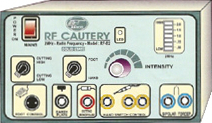Radio Frequency Cautery

The Technique of Radio Surgery involves the passage of high frequency radio waves (2 MHz) through soft tissue to cut, coagulate, or remove the tissue. Soft tissue resistance to these radio waves causes the cellular water in the soft tissue to heat, which produces steam and results in cellular molecular dissolution of individual tissue cells.
The surgeon uses a hand piece with an active electrode (different type of electrodes for different applications) to transmit the radio waves. The radio waves are focussed on the tissue by an antenna plate (Patient plate) that is positioned behind the tissue in contact with patient’s skin.
Radio surgery in general practice has many advantages over conventional surgical techniques particularly dermatological, plastic and eye lid surgery, ENT, dental, gynaecological – quicker operating time, rapid healing, less tissue damage and less post-operative discomfort and it’s wider use in hospital is recommended.
Radio frequency is not to be confused with electro-surgery machine (surgical diathermy) spark gap circuitry unit (electro-cautery) and uses completely new technique compared with scalpal surgery and other techniques and Radio energy does the cutting very light. A very high frequency radio wave 0.3 – 2 MHz and a fine needle or wire loop electrode which is held by the surgeon, radio energy passes between the cautery electrode and patient plate. It is concentrated at the needle end or wire loop electrode, resulting in the release of energy, which produces steam within the cells, thus vaporizing them and dividing the tissues.Advantages
- Minimum heat with no charring resulting in least tissue damage
- Cutting & fulguration is optional
- Minimum blood loss & pain
- Shock proof
- Local anaesthesia is not required on the surface of the skin or in superficial procedures
- Sparkless integrated circuit of latest technology for fast and continuous procedures
- Pin point cutting capability

Standard Accessories
- Monopolar Handle - 1 No.
- Patient Plate - 1 No.
- Electrodes Set - 1 No.
- Foot Switch - 1 No.
- Carrying Case - 1 No.
- Hand Switch - 1 No.
- Bipolar Cable - 1 No.
- Bipolar Forcep - 1 No.
Size
Weight
Specification
- Power input 220 volts +-5%
- Power consumption 150 Watts
- Frequency 2 MHz
- Maximum Output
- HF Monopolar 150 Watts on 400 Ohm load
- HF Bipolar 100 Watts on 100 Ohm load
- Fulguration 100 Watts on 1000 Ohm
Various Applications of RF Cautery for ENT, Dermatology and Plastic Surgery
- Adenoidectomy
- Laryngeal Disorders
- Keloid Surgery
- Nasal Polypectomy
- Nose Bleeding
- Removal Ranula Cyst
- Snoring
- Tonsil and Adenoid
- Tonsil tumor
- Wart, Nevus Skin Tumor
- Nasal Mucosa
- Nasal Tumor
- R.F. of Palate
- Tonsilectomy
- Turbinate
Various Applications of RF Cautery for Opthalmology
- Oculoplastic Surgery
- Ptosis Surgery
- Blepharoplasty
- Endoscopic brow lift
- Endonasal DCR
- Mucous membrane / Palate grafts
- Conjunctival Surgery
- Canthoplasty
- Eyelid reconstruction
- Punctal Occlusion
- Orbital Surgery
